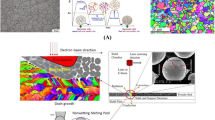Abstract
Mathematical models have been developed to predict the removal of alumina inclusions from molten steel in a continuous casting tundish, including the effects of turbulent collisions, reoxidation, flotation, and removal on the inclusion size distribution. The trajectories of inclusion particles are tracked through the three-dimensional (3-D) flow distribution, which was calculated with the K-ɛ turbulence model and includes thermal buoyancy forces based on the coupled temperature distribution. The predicted distributions are most consistent with measurements if reoxidation is assumed to increase the number of small inclusions, collision agglomeration is accounted for, and inclusion removal rates are based on particle trajectories tracked through a nonisothermal 3-D flow pattern, including Stokes flotation based on a cluster density of 5000 kg/m3 and random motion due to turbulence. Steel samples should be taken from as deep as possible in the tundish near the outlet and at several residence times after the ladle is opened, in order to best measure the Al2O3 concentration entering the submerged entry nozzle to the mold. Inclusion removal rates vary greatly with size and with the presence of a protective slag cover to prevent reoxidation. The random motion of inclusions due to turbulence improves the relatively slow flotation of small inclusions to the top surface flux layer. However, it also promotes collisions, which slow down the relatively fast net removal rates of large inclusions. For the conditions modeled, the flow pattern reaches steady state soon after a new ladle opens, but the temperature and inclusion distributions continue to evolve even after 1.3 residence times. The removal of inclusions does not appear to depend on the tundish aspect ratio for the conditions and assumptions modeled. It is hoped that this work will inspire future measurements and the development of more comprehensive models of inclusion removal. These validated models should serve as powerful quantitative tools to predict and optimize inclusion removal during molten steel processing, leading to higher quality steel.
Similar content being viewed by others
References
H. Tanaka, R. Nishihara, I. Kitagawa, and R. Tsujino: Iron Steel Inst. Jpn. Int., 1993, vol. 33 (12), p. 1238.
K.H. Tacke and J.C. Ludwig: Steel Res., 1987, vol. 58 (6), p. 262.
H.B. Kaufmann, A. Niedermayr, H. Sattler, and A. Preuer: Steel Res., 1993, vol. 64 (4), p. 203.
K. Tozawa, Y. Kato, and T. Nakanishi: CAMP-ISIJ, 1997, vol. 10, p. 105.
A.K. Sinha and Y. Sahai: Iron Steel Inst. Jap. Int., 1993, vol. 33 (5), p. 556.
J.W. Hlinka: in Mathematical Process Models in Iron-Steel Making, The Metals Society, London, 1975, pp. 157–64.
S. Chakraborty and Y. Sahai: Ironmaking and Steelmaking, 1992, vol. 19 (6), p. 479.
S. Chakraborty and Y. Sahai: Ironmaking and Steelmaking, 1992, vol. 19 (6), p. 488.
J. de J. Barreto S., M.A. Barron Meza, and R.D. Morales: Iron Steel Inst. Jpn. Int., 1996, vol. 36 (5), p. 543.
Y. Miki, B.G. Thomas, A. Dennisov, and Y. Shimada: Iron and Steelmaker, 1997, vol. 24 (8), pp. 31–39.
FLUENT User’s Guide, Fluent Inc., Lebanon, NH, 1995, vols. 1–4.
K. Asano and T. Nakano: Tetsu-to-Hagane, 1971, vol. 57, pp. 1943–51.
H.C. de Groh III, P.D. Weidman, R. Zakhem, S. Ahuja, and C. Beckermann: Metall. Trans. B, 1993, vol. 24B, pp. 749–53.
R. Zakhem, P.D. Weidman, and H.C. de Groh III: Metall. Trans. A, 1992, vol. 23A, pp. 2169–81.
H. Yasuhara, Shimura, and S. Nabeshima: CAMP-ISIJ, 1996, vol. 5, p. 785.
S. Joo, R.I.L. Guthrie, and C.J. Dobson: Steelmaking Conf. Proc., 1989, vol. 72, p. 401.
P.G. Saffman and J.S. Turner: J. Fluid Mech., 1956, vol. 1, pp. 16–30.
K. Nakanishi and J. Szekely: Trans. Iron Steel Inst. Jpn., 1975, vol. 15, pp. 522–30.
K. Higashitani, K. Yamauchi, Y. Matsuno, and G. Hosokawa: J. Chem. Eng. Jpn., 1983, vol. 116, pp. 299–304.
U. Lindborg and K. Torssel: Trans. TMS-AIME, 1968, vol. 242, pp. 94–102.
Author information
Authors and Affiliations
Rights and permissions
About this article
Cite this article
Miki, Y., Thomas, B.G. Modeling of inclusion removal in a tundish. Metall Mater Trans B 30, 639–654 (1999). https://doi.org/10.1007/s11663-999-0025-6
Received:
Issue Date:
DOI: https://doi.org/10.1007/s11663-999-0025-6




